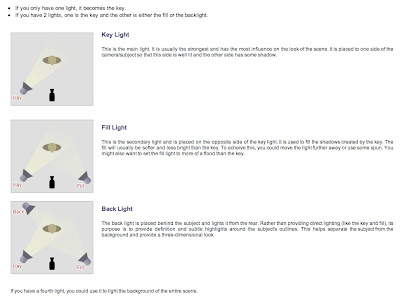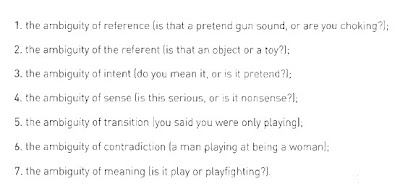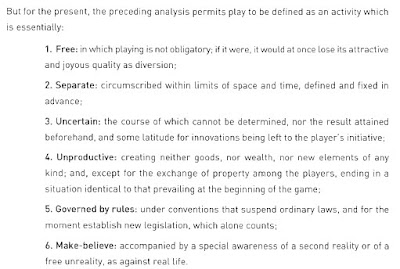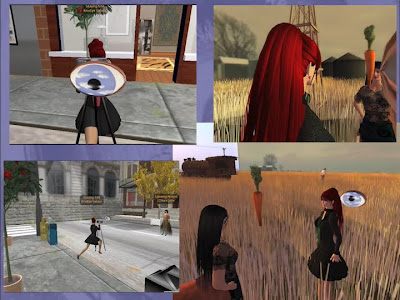Course blog for LHUM 433: Digital Narrative Theory & Practice, Spring 2011, Berklee College of Music. Taught by Lori Landay. Part of the Video Game Scoring Minor and the Visual Culture & Interactive Media Studies Minor.
Monday, May 23, 2011
Virtual Art Presentation
Thursday, May 5, 2011
Technology of the Future Chart
I just found this and thought it was extremely relevant to topics we discussed in class.
Take a look!
Here's the link too: http://michellzappa.com/map/envisioning-technology-2011-03-07.png
Saturday, April 30, 2011
Thursday, April 28, 2011
The Queen of Tarts Game
Have fun and good luck!
-Kristin
Tuesday, April 26, 2011
Paidia and Ludus Revisited
Thursday, April 7, 2011
PROJECT PLANNING WORKSHEET (“It furthers to have somewhere to go.”)
PROJECT PLANNING WORKSHEET (“It furthers to have somewhere to go.”)
With a partner, work through the steps on this sheet. You can interview or guide your partner through the parts, then switch.
1) Project idea:
2) Title:
3) Break it down into pieces.
COMPONENTS TOOLS
4) What new skills do you need to learn? How will you learn them?
Sunday, April 3, 2011
Tuesday, March 29, 2011
Cinematography and Machinima
MISE-EN-SCENE: What's in the shot
Setting
Costume
Lighting
Figure Expression and Movement
LIGHTING: 3 POINT LIGHTING: key, fill, back

MACHINIMA: Environment lighting, and also lighting kits, or lights you make
PHOTOGRAPHIC QUALITIES OF THE SHOT
Look of an image
balance of dark and light
depth of space in focus
relation of background and foreground
use of color, saturation, tone
focus
lenses to change depth in a shot (either fixed with a telephoto or fish eye, or rack or zoom shots)
FRAMING
Angle
Height of the camera
Canted angles
Following shot (moving camera):PANNING, TRACKING, TILTING, CRANING
Point of view shot
SCALE/PROXIMITY
ELS: landscape, crowd, building--establishing shot
LS: Standing human figure is height of screen (roughly)--character and surroundings
MLS: knees/mid-thigh up (shot Americain bc of its use in cowboy pictures)
MCU: chest up--get to see the face, gestures
CU: head
ECU: small object, part of the body
CAMERA MOVEMENT
crane
handheld, steadycam
pan
tilt
tracking shot
whip pan
For Machinima: Space Navigator 3-d mouse
What to do with those shots!
EDITING AND MONTAGE
Editing can be based on rhythm, time, space, tone, theme
"The Kuleshov Effect" With his experiment, Kuleshov learned 3 things:
1) a cut could serve a narrative function (eyeline match, flashback, what a character is thinking)
2) also it could generate an intellectual response—(metaphor, contrast, parallel)
3) emotional cut: rhythmic, tonal (increasingly dark or light0, form cut (match cut), directional cut
a single cut can function on all three levels: narrative, intellectual, emotional
Straight cut
Jump cut
Cross cut (or parallel cut)
Contrast cut
Form cut (match cut)
TRANSITIONS:
Fade-out
Fade-in
Dissolve
Synecdoche (part for a whole)
Form dissolve
Wipe
Iris
Monday, March 21, 2011
Ambiguity! (Is that clear?)

Thursday, March 10, 2011
This is really cool
Awesome TED talk on educational systems using digital media.
Caillois

Paidia: "uncontrolled fantasy," "frolicsome and impulsive exuberance," "anarchic and capricious"
Ludus: "arbitrary, imperative, and purposely tedious conentions," "completely impractical," "requires an ever greater amount of effort, patience, skill, or ingenuity."
Agôn
Alea
Mimicry
Ilinx
Recall our Play! workshop (see cut scenes again here)
Monday, March 7, 2011
Games and Film: Where Aesthetics Meet and Diverge
Opening shot of Welles's Touch of Evil that Solis discusses in his blog post:
Solis writes, "So why do we introduce the camera before we introduce the main character? Simply the camera is more important then Mario in this title." Does Welles's film also introduce the camera before the character?
How has this evolved in games? In film? Why?
Sunday, March 6, 2011
Jessica Huber's Fairy Tale Assignment
Wednesday, March 2, 2011
Building & Machinima Workshop
First, as an example of engaging use of machinima and also an edifiying and entertaining tutorial on the camera:
Friday, February 25, 2011
Reactive Music, and Some Questions
So here are my questions: What is the visual equivalent of reactive music/sound? The Ascend scene I used for both pieces here doesn't only overlay your recorded sound, but uses it to generate music based on a composition by composer Dizzy Banjo.
And what is the narrative, or storytelling, equivalent????? Can we think about augmented storytelling? What would that be?
You need to have Flash installed to listen directly on the site. Install Flash or you can download the recording instead
 Recorded from Ascend. Check out more recordings from Ascend...
Recorded from Ascend. Check out more recordings from Ascend...
Thursday, February 24, 2011
Kino Eye, Cultural Interfaces,Agency, Storytelling: Synthesis
Monday, February 14, 2011
Cultural Interfaces & Machinima

Today we'll connect the reading you've been doing in Manovich's book with the Unity 3D workshop we did last week and the machinima workshop we'll do this week. As we learn new software programs and become more aware of how cultural forms like games or movies are constructed, we learn new aspects of their interfaces, and I'll keep drawing your attention to that, asking you to reflect upon your experiences as both a maker and a player/spectator/reader of digital narrative. So we need to think a little about subjectivity, and how narrative, and particularly digital narrative can construct it.
Tuesday, February 8, 2011
Forking Paths
Tuesday, February 1, 2011
Game Design Workshop Notes
 Today, we cram our snowed-out 2-hour discussion of the first 4 chapters of Game Design Workshop into a 50-minute class, and try not to think of the snow piling up outside.
Today, we cram our snowed-out 2-hour discussion of the first 4 chapters of Game Design Workshop into a 50-minute class, and try not to think of the snow piling up outside.Monday, January 24, 2011
Digital Narrative: Play!
Digital Narrative: Myth & Story
Wednesday, January 19, 2011
Transmedia, Shigeru Miyamoto: The Big Picture of Digital Narrative
From Jenkins:
"In the ideal form of transmedia storytelling, each medium does what it does best-so that a story might be introduced in a film, expanded through television, novels, and comics, and its world might be explored and experienced through game play. Each franchise entry needs to be self-contained enough to enable autonomous consumption. That is, you don't need to have seen the film to enjoy the game and vice-versa. As Pokemon does so well, any given product is a point of entry into the franchise as a whole."
The example of Lost
The example of Star Wars
Your examples
Here is the link to the New Yorker profile of Nintendo game design genius Shigeru Miyamoto, and we'll discuss the attitude towards gaming presented in the article as well as the example of Miyamoto.
Miyamoto's caves
Huizinga and Callois
Influence of Miyamoto
Monday, January 17, 2011
Overview
The overall theme of the course will focus on moving image narratives--both linear and non-linear--that explore ideas about storytelling, time, and memory. In particular, we will consider how interactivity changes narrative, and whether there are new kinds of digital narratives and aesthetics emerging, especially in games, and in what games might become. Students will make movies, games, websites, DVDs, and online installations that illuminate ideas about story, plot, character, time, and narration, comment on their creative work using the critical concepts they learn, and experiment with word processing, graphics, machinima capture, video editing, game design, and web design software programs.
All students will analyze their own responses to the games, films, readings, and other media we encounter in terms of the key concepts from the course in order to deepen their understanding of how meaning is made in digital narrative and interactive media, to enhance the production of their own creative projects, and to explore the nature and complexity of the role of digital media in our society and culture. Students in the Video Game Scoring Minor will focus on deepening their understanding of the subjective experiences of game play and narrative in a range of interactive media in order to be better able to score video games effectively and creatively.
LEARNING OUTCOMES
By the end of this course, you will be able to:
1) Evaluate current theoretical and practical tendencies in the emerging field of Interactive Media.
2) Formulate a critical framework for analyzing traditional and new forms of narrative.
3) Develop narratives that employ the theoretical and critical concepts explored.
4) Apply new media tools and aesthetics to create digital narrative.
5) Analyze the subjectivity of a game, immersive, interactive, spectatorial, or narrative experience so that you are better able to compose music for that medium, and be better at communicating with the people who make the kind of media you will score.
6) Synthesize theory and practice in an interdisciplinary exploration of narrative and technology.
7) Connect academic studies and the changing world in which we live.
COURSE MATERIALS: Required Books, available at bookstore & online
The Language of New Media, Lev Manovich (LNM)
Game Design Workshop , Tracy Fullerton (GDW)
Recommended: Man, Play, and Games, Roger Callois





